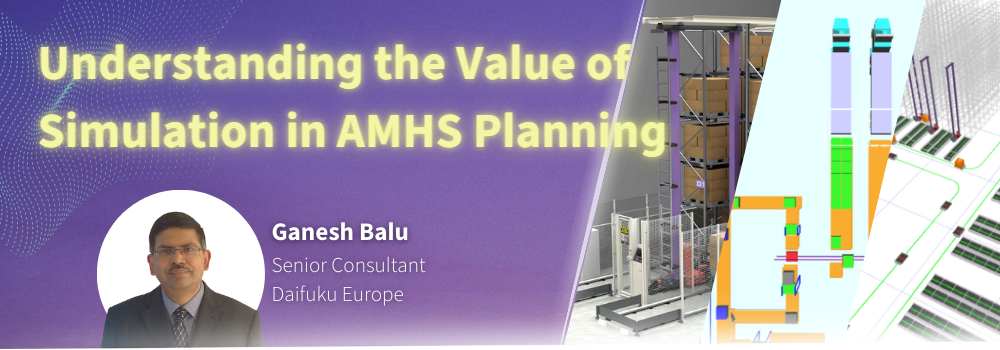Understanding the Value of Simulation in AMHS Planning

One of the techniques that engineers use to validate the design of a complex automated material handling system (AMHS) is to create a simulation of the system (a model) to get an idea of how the system will perform. The model is developed considering the presumptions that have gone into the design, which combine the business rule constraints as well as the equipment/controls specifications.
Before getting into the discussion of a simulation, it is worth discussing other useful models that are also used in the industry and sometimes confused with simulation, namely, "animation" and "emulation." The definitions for each of these are not widely standardized in the industry, so it is always good to check when you are having a conversation with someone to ensure you are on the same page.
Animation
Animations are typically 3D models of a proposed system created in software that enables zooming, rotation, and often movement of loads, equipment, and operators. They are generally made to create a better understanding of how a system will operate and are extremely useful in presenting to people who are in a position of approving a project but not necessarily well-versed in automated material handling from a technical perspective. Animation ignores most timing and detailed logic—its purpose is to educate, not validate. Their importance should not be down-played however. An animation is often the way that key stakeholders can understand how a system will work and what advantages it will bring.
Animation example
Emulation
Emulation generally means that a virtual 3D model of the system is created wherein even detailed logic is included in the model, including sensor positions, equipment speeds and accelerations, as well as human interfaces, barcode scanners, etc. Higher level software such as warehouse control systems (WCS) may also be included.
Emulations can be very helpful to debug the actual controls of a system before a system is implemented on site. In fact, since there is the ability to create as many loads as needed for any test, and also the ability to look at the entire layout at the same time, this actually means a higher level of controls verification/troubleshooting can be done with emulation than might be accomplished during actual on-site commissioning.
On the other hand, emulations are usually not very adept at looking at system concept design, as the models do not typically contain anything to create controlled variability, take statistics on equipment utilization, take significant system level data, etc. These kinds of system concept validation are in the realm of simulation.
Emulation example
Simulation
While it can be used for many things, generally the most important purpose of a simulation is to verify that a system concept will meet the required throughput.
A simulation model is one wherein the general layout, equipment speeds, operations and controls logic of the proposed system are all programmed into the model. Some key inputs included in the model are the number of buffer positions and appropriate macro controls.
Furthermore, besides just the logic to run the simulation, it is important to program the gathering of statistics about utilization, numbers of successful transports, and lead times among other points, as these can give significant insight into overall system performance.
Another important factor for simulations is that they include appropriate "randomness" logic/settings that might attenuate events/flows in the same way that they might fluctuate in the real-world, even though such a fluctuation might never appear in any data available. The primary function of a simulation is to make sure that a system will be able to meet throughput while following whatever business rules the end-user may have established. That randomness allows engineers to peek into the "what ifs" of day-to-day occurrences, thus providing quite a solid verification of the concept proposed.
Simulation example
Summary
A system animation gives a very general understanding of how a system will function but does not factor in detailed logic or throughput requirements. Think of it as highlighting how the system will look and a general overview of the flow of goods.
Emulation checks the controls and sensors of the system to ensure that the direction of goods and speed of equipment are all as required.
Simulation looks at throughput and can help identify and eliminate bottlenecks, make sure that both equipment and operators are being utilized at appropriate levels, which may also include determining the correct number of certain devices and identifying the number of operators required, and give hints as to flexibility for future growth. Often, it is discovered that a planned design concept will work, but that tweaks to conveyor buffers, numbers of transport vehicles, and other minor system modifications whether it be in equipment or logic will be necessary, or desirable, for further optimization.
Whether a simulation is necessary or not depends on the complexity of the system. When in doubt, consult with your system provider for guidance. When it is deemed necessary, a simulation can offer a tremendous peace of mind for all stakeholders.
Total Solution Experience
System design is one element of the AMHS creation process. At Daifuku, we take an end-to-end approach and work with our customers from initial consultation all the way through to after-sales service. Interested to know more? Check out our Total Solution Experience page to learn more.
Ganesh Balu

Senior Consultant, Daifuku Europe
Having joined the Daifuku Group in 1997, Ganesh Balu has over 25 years experience in the materials handling industry focusing on the design of automated solutions for Intralogistics. He started as an Engineer in the Simulation Group in Daifuku Japan before moving to Daifuku Europe in 2006 where he is currently a Senior Consultant in the UK Branch. He completed his higher education in India with a Bachelor's in Mechanical Engineering from the University of Madras and a Master of Science degree from the Indian Institute of Science.
